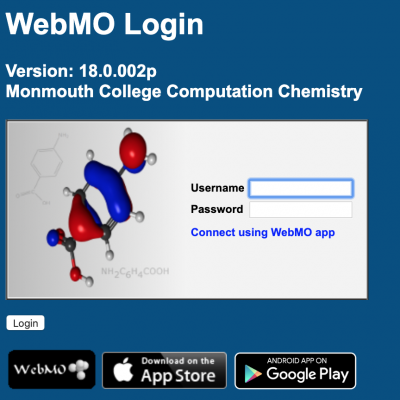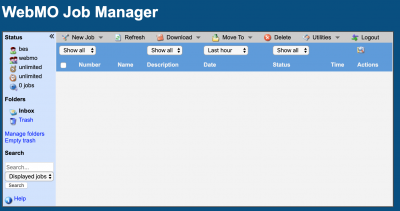Comp Chem 01
(4/9/20, bes)
Welcome to the first of a few lab periods that we will focus on computational chemistry. This work will be using the WebMO Pro 18.0 software that is linked in the left menu bar on this wiki. You must have a WebMO account; you can use the password recovery if needed.
About the Hardware
When I first came to Monmouth in 2007, I negotiated startup funds of $25K, thanks to Doc Kieft who encouraged me to make this request as well as assisted in the negotiations with the Dean and the board of trustees. As a part of these funds, i purchased a MacPro and computational software (see below). This was an Intel-based Mac tower that had a "Quad Core" (two 2.66 GHz dual core) Intel Xeon 5150 processor (see specs below). In 2016, this server had a "fatal" hardware crash, no beeps, no nothing (the power supply was fine). I decided to purchase an identical computer from the used market (~$200), swapped hard drives, reconfigured the network and...back up and running. After this crash and as pchem and research students began to rely on this hardware, I decided to upgrade the hardware in 2017. The new computational server is an iMac Pro with an 8-Core, 3.2GHz Intel Xeon W processor. The old server is now the chemistry wiki, from which you are reading this document! By the way, i have a new Linux-based wiki server that is currently running the local Section ACS webpage and will be the new Chemistry wiki when i get around to it.
About the Software
Computational software has a history of being very user unfriendly. This was the case because nearly all people doing computational work were quite comfortable with computers and coding. It was and is still the case, that in order to submit a computational job, you must create an input file that is very sensitive to syntex. One of the first companies (1991) to make a user friendly interface was Wavefunction who made Spartan Software. In 2001, when i was at Western Carolina University, i purchased a computer cart with 12 laptops and 12 licenses to Spartan. I was not totally happy with the "ease of use" of the software and i was unhappy about the fact that each computer required a "dongle" (USB drive-looking device containing the software authentication). Dongles were checked out and ultimately would be misplaced (my bad management) and classroom activities would suffer. Although Spartan is an awesome software package, it was quite expensive ($?) and the software license was complicated.
After attending a few workshops on computational chemistry (one in 2003 where i meet Jeff Draves, a Monmouth College Physical Chemistry faculty member - the job i now hold) i learned about WebMO. Version 1.0 was released in Feb 2000. WebMO is a free internet-based management system for computational chemistry. Being internet-based, access to the resource is very easy for users and does not require much IT maintenance. The main task of WebMO is to prepare the input file for a computational software, aka "computational engine". There are a number of free computational engines available that can be interfaced to WebMO. The history of WebMO is not clearly touted on the WebMO webpage, but it was started by William F. Polik of Hope College and 2001 Hope Chemistry graduate Jordan Schmidt. WebMO has been spun off from the College as WebMO LLC. Hope College's COMPUTATIONAL SCIENCE AND MODELING Laboratory carries on the WebMO tradition.
WebMO is an interface to computational engines. The engine we will be using is from Gaussian and is a version 03, meaning the 2003 version. At this time (2020) there have been two additional releases 2009 and 2016. An online version of the Gaussian03 manual is available.
Why do Computational Work
From Hope College's CSM Laboratory statement of "MOTIVATION"
- Computational modeling is one of the most significant developments in scientific inquiry in the 20th Century. While scientific research has been successful in identifying the fundamental laws that govern our world, the advances promised by these discoveries have not been fully realized because the real-world systems governed by these laws are often extraordinarily complex. Computer-based modeling provides a way to understand and predict the behavior of complex systems based on knowledge of these fundamentals laws combined with experimental and/or observational data.
As noted above, computational modeling is based off of the fundamental laws that govern our world'.' There are two distinctive paths when it comes to fundamental laws: 1) classical mechanics, and 2) quantum mechanics. When it comes to molecular systems, classical mechanics can attempt to address some dimension to our world'.' This approach uses a "ball and spring" strategy to position elements in a complex arrangement; this staraty is often referred to as molecular mechanics. Computations that use quantum mechanics are referred to as ab initio methods. There are a variety of hydride techniques that use both classical and quantum mechanics. When experimental data is infused into the calculation, we refer to this as semi-imperical methods.
Monmouth College's Computational Resources
MC hosts WebMO Pro (version 18.002p) with the main computational engine, Gaussian 03. The "pro" version allows for more advanced visualization of the output file. Gaussian 03, as the name implies is the 2003 version of the Gaussian engine. When logging into the systems you will first see this welcome screen, your Username and Password came from or will be provided in lab.
Running a job
Once you log on you will be meet by the "WebMO Job Manager" window:
In order to start/submit a job, you need to select the New Job / Create New Job tab in the upper left corner. This will then lead you to the "Build Molecule" window:
The following is a set of activities meant to train you in the use of WebMO and computational chemistry approaches.




